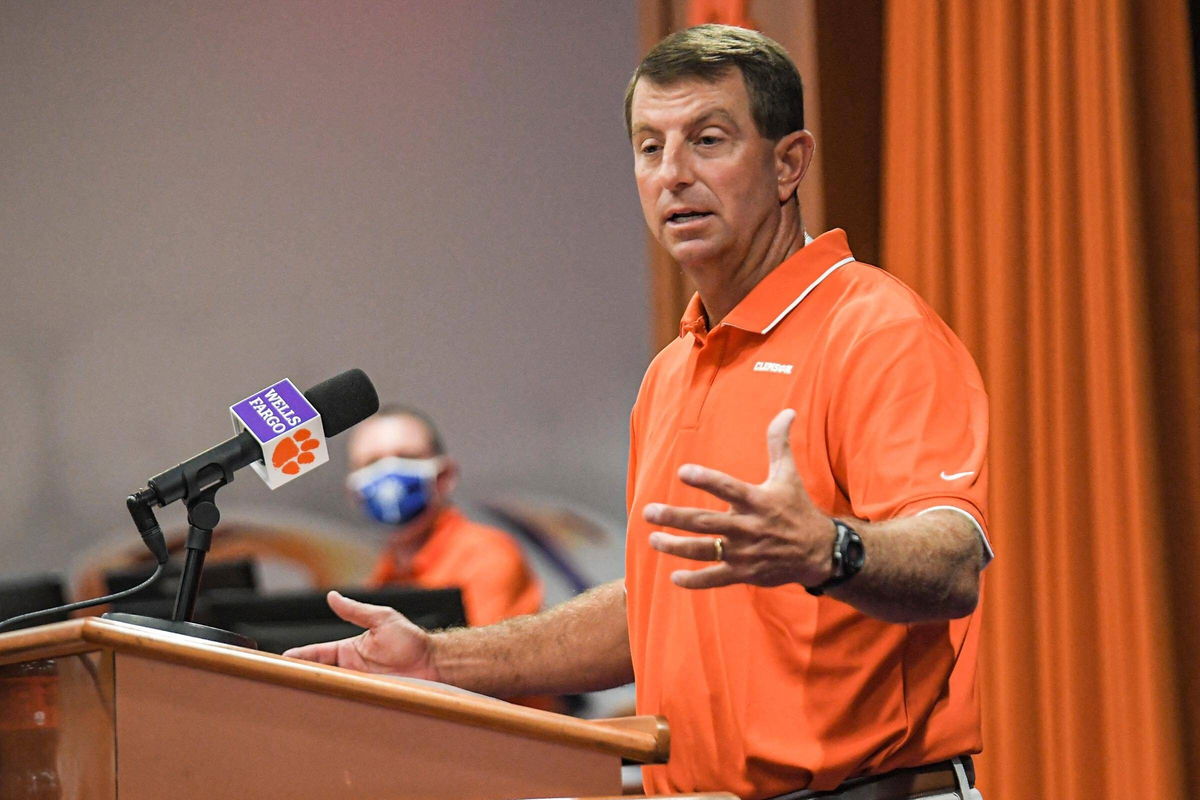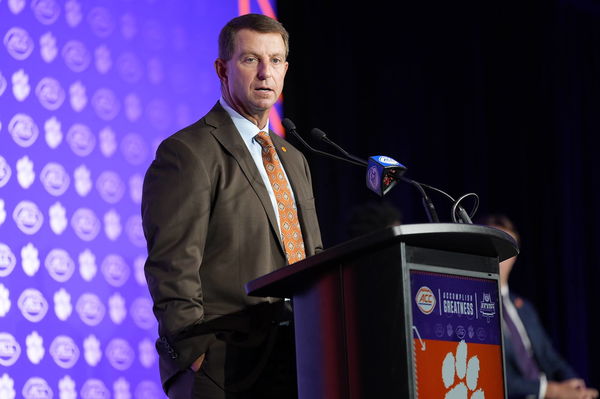
Imago
Syndication: The Greenville News Dabo Swinney talks with media during a weekly press conference, PK, Pressekonferenz in the Poe Indoor Facility team room in Clemson, S.C. Tuesday, August 31, 2021. Dabo Swinney Aug 31 Presser Greenville SC , EDITORIAL USE ONLY PUBLICATIONxINxGERxSUIxAUTxONLY Copyright: xKenxRuinardx/xstaffx 16701753

Imago
Syndication: The Greenville News Dabo Swinney talks with media during a weekly press conference, PK, Pressekonferenz in the Poe Indoor Facility team room in Clemson, S.C. Tuesday, August 31, 2021. Dabo Swinney Aug 31 Presser Greenville SC , EDITORIAL USE ONLY PUBLICATIONxINxGERxSUIxAUTxONLY Copyright: xKenxRuinardx/xstaffx 16701753
In college football, letting go of longtime head coaches has long been part of the game. Deshaun Foster, Mike Gundy, Sam Pittman, and the headlines keep coming. This week, Oklahoma State abruptly fired Mike Gundy just three games into the season, shaking up the landscape. For nearly 20 years, Gundy had been the face of the program, racking up 170 wins, 18 straight winning seasons, and a Big 12 title. But in today’s game, coaching is more about navigating the NIL era, staying current, and managing players who wield more influence than ever. But traditional coaching methods may no longer be compatible with the NIL era.
Watch What’s Trending Now!
In the recent episode of Nightcap, Shannon Sharpe and Chad “Ochocinco” Johnson broke down how veteran coaches are struggling to adapt as he read out what the GOAT of CFB had to say on Mike Gundy’s firing. “Some people have a tougher time embracing the whole idea of paying players, especially some of us old-timers. It’s a little bit more difficult. Embracing paying the players has been a little bit harder and I think ultimately that’s what got them at Oklahoma State.”
Sharpe then warned, “It’s gonna get Dabo too.” Johnson echoed the sentiment, emphasizing the stakes of adaptation, “And the fact that if you don’t want to pay now, you seeing it might cost you your job on the back end because you got to play, you got to pay to win. One thing you got to do in life, no matter what you do is you got to evolve with the times. Pay to play. You got to evolve with the times.” NIL is an evolutionary shift for coaches who grew up in the era when players didn’t get paid, and ignoring it can have disastrous effects on a coach’s career, as Oklahoma State’s experience demonstrates.
ADVERTISEMENT

Imago
NCAA, College League, USA Football: ACC Kickoff Jul 24, 2025 Charlotte, NC, USA Clemson Head Coach Dabo Swinney answers questions from the media during ACC Media Days at Hilton Charlotte Uptown. Charlotte Hilton Charlotte Uptown NC USA, EDITORIAL USE ONLY PUBLICATIONxINxGERxSUIxAUTxONLY Copyright: xJimxDedmonx 20250724_neb_db2_034
Sharpe’s frustration with the old-school mindset was evident, as he added, “Dabo makes 112 million a year. Why do you care? In order to still build a good competitive team and go to that and win national championships, why do you care if a player makes a million, $2 million? It’s not coming out of your salary. I don’t know. It’s just something, you know, he’s an old school coach, huh?“ Even two national championships and a $115 million contract cannot protect a coach forever if the team fails to meet expectations.
And currently, the old school mentality is under fire. For Swinney, the stakes are high; for Gundy, ignoring NIL ultimately resulted in an abrupt downturn. For Pittman, the cracks appeared in the overall losing record, as well as struggles in close games and NIL battles. A poor finish this season could lead to a repeat of the Gundy situation, demonstrating that even the most successful coaches can be overthrown if they fail to adapt to changing times.
ADVERTISEMENT
Mike Gundy fired as NIL era demands change in college football
This season, Oklahoma State’s downfall became very clear, and it all began with a trip to Oregon. Regents, donors, and athletic officials flew to watch the Cowboys play the Ducks, but what they witnessed was more than just a game; it was a wake-up call. OSU suffered the most devastating defeat since 1907 as they got crushed 69-3. One OSU source stated, “I believe there was a group of people who simply wanted to see change.” Two weeks later, Stillwater suffered its first loss to Tulsa since 1951, which confirmed what many had feared: the program was falling behind the changing landscape of college football, particularly in the NIL-driven era.
ADVERTISEMENT
During his 35 years at OSU, Mike Gundy recorded 170 victories, 18 straight winning seasons, and a Big 12 championship. But things had changed in college football. Players were leaving for better opportunities due to big-money programs and NIL deals, and the Cowboys’ roster expense fell short of that of the best teams. According to an OSU source, “it’s just amazing how quickly we slid down.” The team had problems with consistency, injuries, and late arrivals, even after increasing the roster salary to $16 million and adding more than 60 new players. Gundy’s historic run came to an end due to a slow adjustment to the NIL era and pure bad luck on the field.
The actual dismissal came as a sudden but firm blow. Gundy was informed following a staff meeting on Monday, during which he attempted to unite the team, improve strategies, and boost morale through celebrations and music. Chad Weiberg, the athletic director, had already delivered the news by Tuesday. Yet, Gundy showed the leadership that defined his career in his final moments, reminding the players that OSU football is more than any one individual and urging them to remain united. The story also serves as a warning to other long-tenured coaches, such as Dabo Swinney, that loyalty is no longer enough to keep you safe in the NIL era. Change with the times, or else you could end up like Gundy or Pittman.
ADVERTISEMENT
ADVERTISEMENT
ADVERTISEMENT

